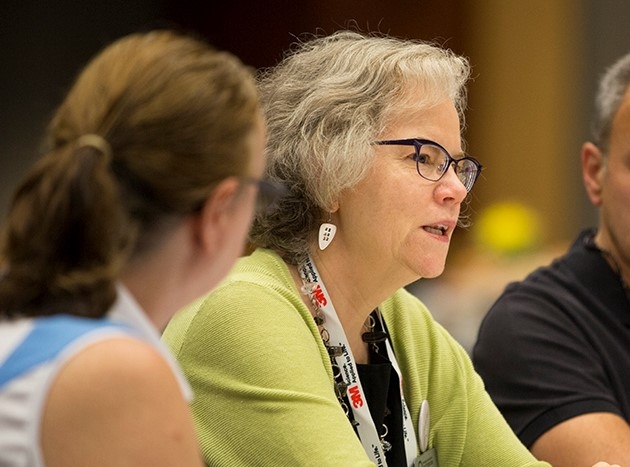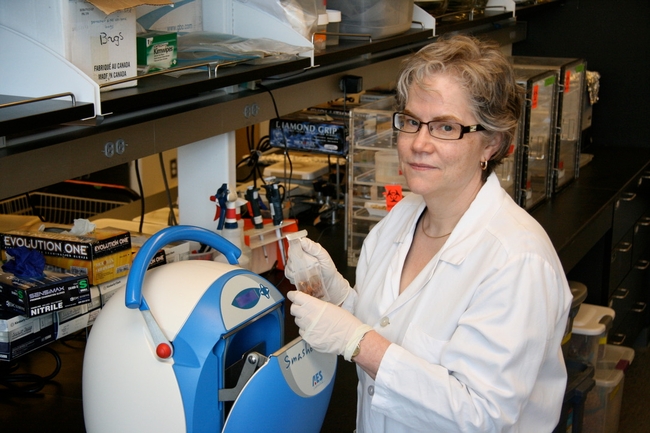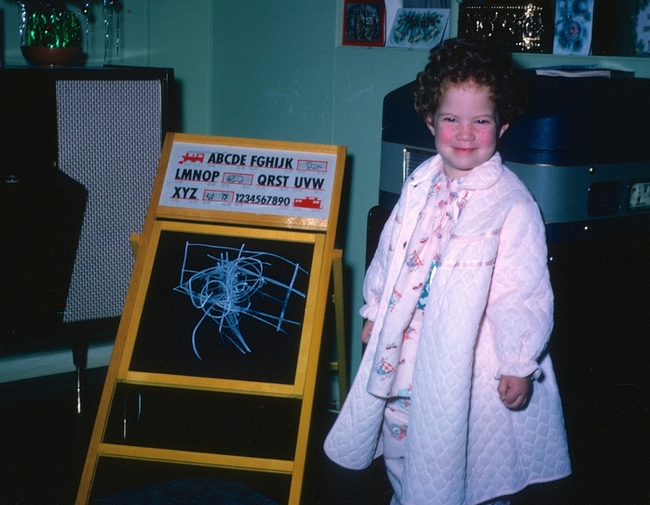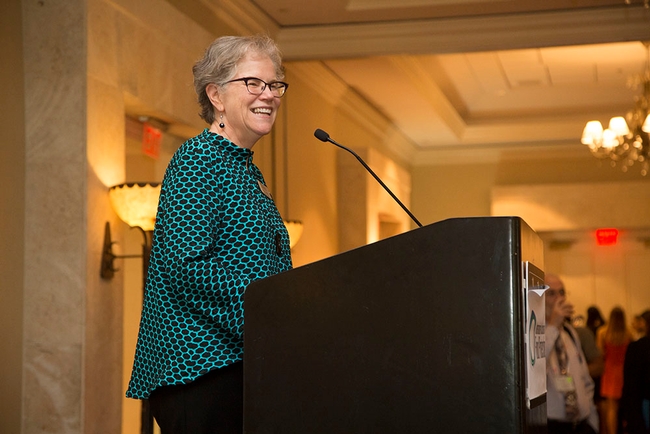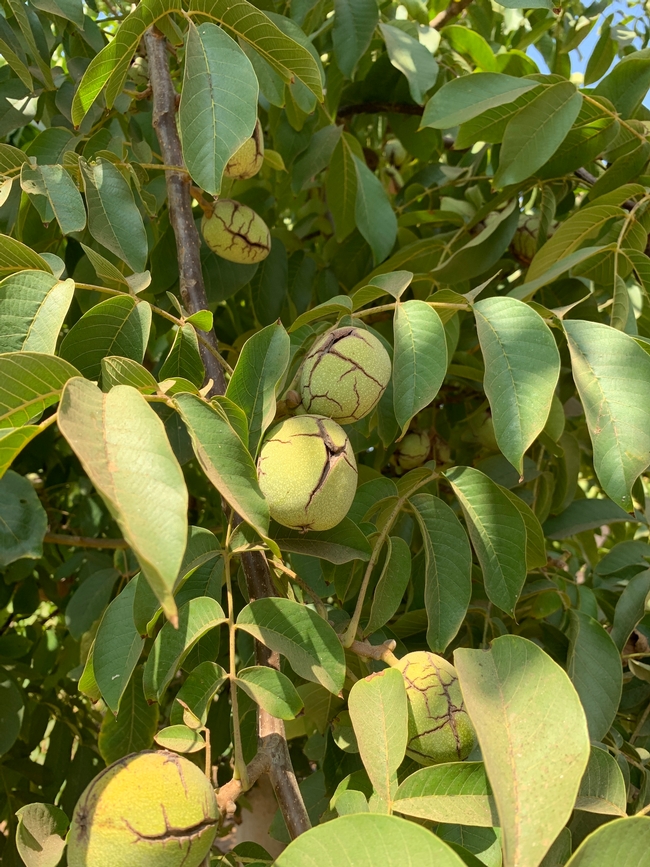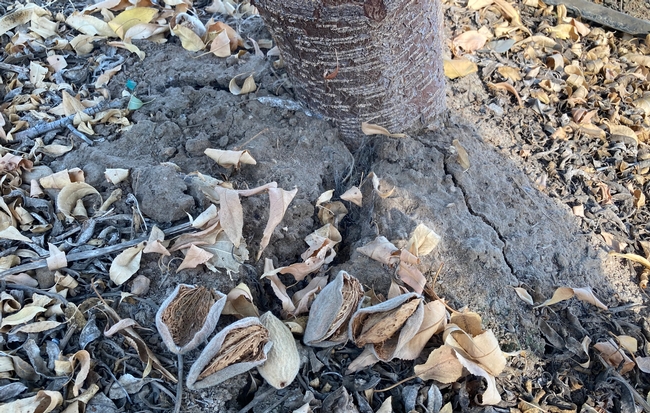
Posts Tagged: Walnuts
Five questions with food safety expert, new AAAS Fellow Linda Harris
Professor of Cooperative Extension shares career story, appreciation for UC Davis
After growing up in northern British Columbia, in a remote smelter town called Kitimat (“an 8-hour drive from the nearest McDonald's”), University of California Professor of Cooperative Extension Linda J. Harris embarked on an academic journey that crisscrossed North America and eventually led to her election as a Fellow of the American Association for the Advancement of Science.
AAAS, the world's largest multidisciplinary scientific society and publisher of the journal Science, recently announced the election of its 2021 class, which will be inducted during its annual meeting, Feb. 17-20.
In addition to Harris – a faculty member in UC Davis' Department of Food Science and Technology – four other UC Agriculture and Natural Resources affiliates will be inducted: Helene Dillard, dean of the UC Davis College of Agricultural and Environmental Sciences; Kathryn Uhrich, dean of the UC Riverside College of Natural and Agricultural Sciences; and UC Berkeley Professors Rodrigo Almeida and Paolo D'Odorico.
Harris, a Certified Food Scientist, recently shared her thoughts on the value of extension work, her contributions to the field, UC Davis' support for women in academia, and the arc of her career journey.
How did you get your start in food science and microbiology?
I was interested in science at an early age. As an undergraduate student at the University of Victoria in Victoria, B.C., I enrolled in biochemistry at the suggestion of my high school biology teacher. In my second year, I switched to the University of Alberta in Edmonton, Alberta and decided to review the course catalog – a paper version! When I got to the section on Food Science, the applied nature of the field just sounded right and I never looked back.
However, I didn't do particularly well in microbiology as an undergraduate student – too much memorization for me. At the end of my B.S. I was ready for a job in the food industry and took the very first job I was offered – ironically enough as a dairy microbiologist in a quality control lab. Thankfully, that job opened my eyes to the possibilities in microbiology. What was memorization turned into something I learned through doing and I was hooked.
Two years later, I was ready to go back to school and contacted a professor of food safety microbiology at the University of Alberta who fortunately had funding for me. During my M.S. degree in food microbiology, he encouraged me to pursue the Ph.D. – which was not something I had ever considered – and that led me to leave Canada and head to North Carolina State University and a Ph.D. in microbiology in the Food Science Department, where I worked on a project related to the fermentation of sauerkraut.
I did have one publication related to food safety during my time at NC State, and when I took my first faculty position back in Canada [University of Guelph in Ontario] I continued to work in food safety, mostly with meat and meat products.
I am so glad that I saw the advertisement for my current position and that I followed my instincts to apply for the job. The opportunities to grow professionally and to work in the food safety area at UC Davis, within the Cooperative Extension network in California, and with collaborators across the U.S., and around the world, have been enormous, and I am extremely grateful for the path that led me here.
February 11 is the United Nations-designated “International Day of Women and Girls in Science.” How has UC Davis supported women in your scientific field?
My career in STEM [science, technology, engineering and math] has been very rewarding and many of the gender barriers I faced early on have been addressed. I feel very fortunate to have landed at UC Davis and I am thankful that there is a long history of addressing these barriers at this institution.
When I was hired in 1996, the Department of Food Science and Technology was about 25% women and both the department chair and dean of the college were women. I had never been in a department or college with so many women faculty, including in positions of leadership. It was a very important consideration in my move. Today our department is 50% women and I proudly served for five years as the second woman department chair, from 2016 to 2021.
As a first-generation university graduate raised by a single mother, you have a unique perspective in encouraging young people on their path toward a STEM career. What advice do you have for them?
To those contemplating a career in STEM, I would say: be open to new opportunities and adventures – you never know where they may lead you. Get involved in leadership in any capacity you can from student organizations or around other things that interest you. Skills that you learn with these types of activities will be invaluable to your career.
I am very much an introvert and had to work hard to overcome my fear of public speaking. In addition to leadership roles in student clubs, I joined Toast Masters while working on my Ph.D. These activities had a huge impact on building my confidence and helped influence my career choices.
In the AAAS Fellows announcement, it says you were elected for “contributions to the field of food safety microbiology, especially related to control of Salmonella and other pathogens in low-moisture foods and fresh produce.” Is that your proudest achievement in the field?
I am most proud of the work described by that short statement especially as it applies to California-grown commodities. I would say that my laboratory is best known for work with the tree nut industry – almonds, pistachios and walnuts, as well as a range of types of fresh produce grown in this state.
My laboratory has worked to understand behavior, movement, prevalence, and especially control of foodborne pathogens like Salmonella during production in the field through harvest and postharvest handling all the way through to consumer practices.
I have been fortunate to have many terrific state, national and international collaborators and an outstanding group of people working in my laboratory as we set the foundation for some of the food safety research in tree nuts and produce. It has been most gratifying to watch the significant growth in these fields of investigation, especially with a new generation of scientists that span the country and beyond.
Another “hat” you wear is UC Cooperative Extension specialist. How have you contributed to food safety knowledge and practices in our communities?
I think you will see that my “hats” are not that different. The research from my laboratory has provided the foundation for several commodity-based, food-safety risk assessments – for almonds, pistachios, and walnuts. And these, in turn, have been used in support of regulations or helped guide implementation of safer food industry practices. Our research has also informed several publications aimed at consumer handling of fresh fruits and vegetables and has been cited in regulations pertaining to fresh produce safety. It is gratifying to see our research being used.
My research and extension work are very integrated. One feeds the other. Because I have been able to interact with stakeholders (especially integral to my position as a Cooperative Extension specialist), I have been able to understand firsthand some of the pressing food-safety issues and challenges in California. These stakeholder interactions have largely formed the basis for most of my research and extension grant proposals over the years. The collaborations that have resulted from extension activities have opened doors and access to many unique opportunities for sample collection and research exploration.
‘UC Wolfskill’ walnut will allow earlier harvest
UC Davis researchers have bred a new walnut variety designed to provide growers a way to harvest earlier and boost the harvest efficiency of California's $1.6 billion walnut industry.
The new “UC Wolfskill” walnut has yield, quality and light color similar to Chandler, which is a late-harvesting walnut and the state's leading variety. UC Wolfskill was bred in 2003 from a cross of Chandler with the Solano walnut. UC Wolfskill combines the color and shell traits of Chandler with the earlier harvest date and kernel fill of Solano.
“The release of UC Wolfskill means growers can spread out their harvest and still have a really high-quality nut that will fetch top-notch prices and provide similar yields,” said Pat J. Brown, breeder and professor with the UC Davis Department of Plant Sciences.
Over 99 percent of the nation's walnuts are grown in California. More than half of the state's bearing acres are the late-harvest Chandler walnuts.
“The California walnut industry needs earlier harvesting walnut varieties to provide efficient use of harvesting, drying and processing equipment,” said breeder Chuck Leslie, with the UC Davis Walnut Improvement Program. “UC Wolfskill can be harvested 12 to 14 days earlier than Chandler and provides consistently light to extra light color.”
Handlers judge the value of a walnut based on its color and how well it halves while processing. In blind quality evaluations by commercial graders, the UC Wolfskill was often not distinguished from Chandler.
UC Wolfskill was originally planted and evaluated at UC Davis, and field trials with growers began in 2011.
“The commitment of our walnut growers, as collaborators, is the foundation that makes this release possible. The Board is extremely grateful for the long-term partnership of our growers and the UC, in finding innovative solutions that help us solve for critical needs,” said Michelle Connelly, executive director of the California Walnut Board.
The California Walnut Board funded the research. UC Wolfskill is currently available to California nurseries for propagation in California and sales to growers throughout the United States. Nurseries interested in propagating and selling this cultivar may obtain a license from UC Davis InnovationAccess.
A hike in navel orangeworm pressure expected later this century due to climate change
Outsized wildfires, rising sea levels and disappearing glaciers are dramatic signs of climate change, but not the only ones. New UC Agriculture and Natural Resources research provides forewarning of a change that will be economically and environmentally costly to California – a fifth generation of navel orangeworm, the most destructive pest of almonds, walnuts and pistachios.
Navel orangeworm (NOW) will be more problematic in the future because of warming temperatures, UC Cooperative Extension scientists report in Science of the Total Environment.
Like most insects,NOW's development rate, physiology, behavior and reproduction are highly dependent on the ambient temperature. When the weather warms in the spring, NOW moths emerge from the nuts left in the tree or on the ground during the winter. After mating, females then recycle those last year's nuts to lay eggs and complete one generation. Adults emerged from that first and subsequent generations then lay eggs on in-season hull-splitalmondnuts, where larvae feeding damages the crop. Typically the pests fly three to four times per year – with more flights in areas with warmer weather.
“Warmer temperatures can result in early activity of the pests in the spring and increased activity during the season,” said Tapan Pathak, the UC Cooperative Extension climate change specialist and the study's principle investigator.
The scientists looked at 10 climate models to determine what nut farmers can expect to face over the next 80 years and applied NOW developmental models to the changing climate. Daily maximum and minimum temperature data were obtained for 1950 to 2005, and future projections stretched to 2100.
“The fifth generation can happen in the next few decades,” said Jhalendra Rijal, UC integrated pest management advisor and co-author of the research. “The climate models suggest that spring will begin earlier. That causes insect activity to start earlier. With increased temperatures through the season, the number of days to complete a generation is less. At the end of 2050 or so, we'll see an extra generation.”
The study focused on 23 counties in the Central Valley, from Shasta County in the north to Kern County in the south, where 1.78 million bearing acres of nut crops are planted. About two-thirds of that acreage is planted to almonds, 20% in walnuts and 16% in pistachios. The tree nut crops were valued at more than $8 billion combined in 2018, according to the California Department of Food and Agriculture.
The completion of the NOW life cycle is faster in pistachio compared to almonds and walnuts, so the potential risk of crop damage and economic loss is higher in pistachio, according to the research report. There are only a few years historically in which the models detected the fifth generation of NOW in Kern County pistachios. The occurrence of the fifth generation in almonds and walnuts was historically nonexistent, but it starts appearing in three southern counties by 2040 and eleven counties by 2100.
“In order to alleviate some of the risks related to navel orangeworm damage to nut crops, it is important to implement integrated pest management practices,” Pathak said.
IPM preventative and control measures include sanitizing the orchard during the winter by removing all the nuts on the ground and in the trees, applying synthetic reproductive hormones to limit the pests' ability to find mates, encouraging natural enemies, judicious of least-toxic pesticides if necessary and harvesting the crop early to avoid a new generation of the pest.
“A better understanding of future navel orangeworm pressure on California's major nut crops can help facilitate and strategize integrated pest management practices in order to minimize production risks,” Pathak said.
The results of the research can also inform growers and pest control advisers about the potential increased threat from other pests as the climate changes.
Cover crop management in walnut orchards: from low-input groundcover to forage intercrop
Over the last few years, UC Davis Weed Science has been testing cover crops for weed suppression in...
New $1 million research project to test mating disruption for pest control in walnuts
The Community Alliance with Family Farmers and UC Cooperative Extension are working with farmers to establish six demonstration sites in walnut orchards that will examine the effectiveness of mating disruption to control two major pests of the crop – codling moth and navel orangeworm.
The three-year research effort is funded with a $1 million award from the California Department of Agriculture Biologically Integrated Farming Systems program.
“The project sites will be in the Sacramento and northern San Joaquin Valleys, but we expect the demonstration to be of interest to walnut farmers across the state,” said Sara Tiffany, CAFF director of ecological farming and the project lead. “Farmers who grow related crops, like almonds and pistachios, will also be able to benefit from the findings.”
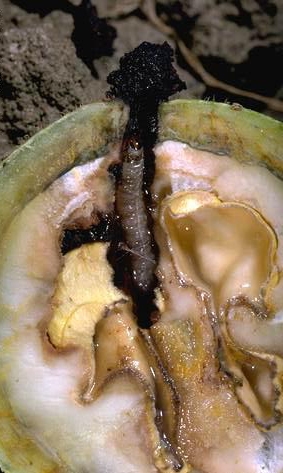
“Farmers need alternatives. In this project, we will be studying the effectiveness of alternatives that already exist,” said Jhalendra Rijal, UC Cooperative Extension integrated pest management advisor for San Joaquin, Stanislaus and Merced counties, the lead scientist on the project. The California Walnut Board is also part of the project team.
Six farmers will be recruited to enroll at least 80 acres each in the demonstrations – three farmers in the Sacramento Valley and three in the northern San Joaquin Valley. The entire acreage will be managed following UC IPM guidelines for walnut production, including cover crops, reduced risk pesticide options and biological control.
Forty acres will be treated with commercially available mating disruption products, while the other 40 acres will not. The treatment works by confusing the pests. Codling moth and navel orangeworm moths naturally release pheromones that help them find mates. The female lays eggs in the immature nuts, and when they hatch, the larvae feed on the nuts, rendering them unmarketable. In the treated area, the orchards will be flooded with a synthetic pheromone that makes it much more difficult for male and female pests to hone in on one another.
Besides codling moth and navel orangeworm, the project will systematically look at the effects of cover crops and predatory mite release on pest mite populations, and improvement in other natural enemy populations in walnut orchards.
The results of the IPM practices will be shared widely with growers, pest control advisors and certified crop consultants in articles, meetings and field days.
“Currently the use of mating disruption in walnuts is significantly lower than in almonds,” said Rijal, who is also the associate director for Agricultural IPM with the UC Statewide IPM Program. “We believe when farmers see the results of using mating disruption, along with other sustainable walnut production practices, we will improve the adoption rate.”

